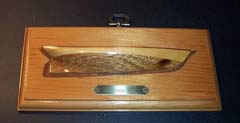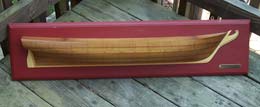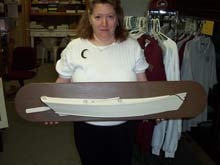Part 1 - Then and Now
Part 2 - Making Plans
You’ve all seen them, hanging in a museum, on the wall of your favorite nautical antiques place or in a nautical accessories catalog. Half of a ship’s hull fastened to a piece of wood. Ever wonder what they were all about? Well, in the next series of articles, I will tell you about them and give you some hints on how to make one of your own boat or of your favorite design.
Half hull models were an important design and sales tool at a time when shipbuilders didn’t have CAD/CAM computers or drawing boards. A time when boats were built without detailed drawings or even any drawings at all. They served as a shipbuilder’s sales tool and then the basis for building the ship itself. Designs were refined and passed on from shipbuilder to shipbuilder through the use of these models.
 |
A Miniature half hull model of the schooner America. Progenitor of the America’s Cup. |
First, the half thing. Ships are symmetrical (at least most were or should have been) along their centerline. So if you knew what one half the ship looked like, the other would be the same but a mirror image. No need to repeat yourself by carving both sides.
Over the years several types of half hull models were developed. The first was the block model, where the entire model was carved from a single block of wood. The second was the lift model, carved from a stack of wood layers of specific thickness temporarily fastened together. A less often used type is the hawks-nest model where cross-section formers were used to support fore and aft strips of wood or stringers that defined the shape of the hull.
The shipbuilder would sit down with the prospective ship owner and the proposed half hull model. The model was a result of that shipbuilder’s cumulative experience, from his own shipbuilding efforts as well as the others he was familiar with. Together he and the owner-to-be would agree on the final details of the proposed ship. In many cases a new half hull model was carved, reflecting the final design that had been agreed upon.
The model itself represented only the hull, from the sheer line to the keel. The model was also carved to the inside of planking. In other words, the dimensions of the model represented the size of the ship less the thickness of planking. This was done so that measurements taken from the model represented the outside dimensions of the ribs (actually called frames on a ship). This was important in times when the hull planking could be as much a three to six inches thick or even more.
| Large half hull of the U.S. Brig Niagara, flagship of Commodore Oliver Hazard Perry at the Battle of Lake Erie. “We have met the enemy and they are ours!” |
 |
With the half hull model on hand and the deal sealed with a handshake, it was time to begin construction. Vertical marks were made on the model, from sheer line to keel. These represented the locations of key frames or ribs. On a block model, strips of lead were bent to conform to the shape of the hull at one of the frame marks. Alternately, the model was sawed in pieces along the vertical lines. These outlines were then transferred to a flat surface, usually a wood shingle or such and then taken to the mold loft floor. There the outline of the frame was expanded to full size and drawn on thin wood as templates.
Once the templates were made, the master shipwright would then prowl the wood yard looking for just the right log with just the right curve. The selected piece would then be sided – to the right thickness, and molded – to the right profile. Most frames were assembled in two layers, with the joints staggered and the whole thing fastened together with treenails or trunnels. Trunnels were wooden pegs driven into holes bored in the frames. From there the frame was erected on the keel and construction moved forward to the next frame.
With a lift model, the various pieces of wood, the “lifts”, could be separated. These were then traced around to form the basis of a “lines plan”. These lifts were scaled to a particular dimension, i.e. a 1/2” lift might equal a foot on the full size vessel. Frame locations were then drawn on the lines plan and the resulting drawing used to fabricate the frames.
Once the ship was finished, the half hull model was often fastened to a piece of planking and hung on the office wall or presented to the ship owner. Today, a half hull model with a verifiable pedigree is worth some real money. Models of clipper ship hulls are pretty rare, as the designing and building of these ships was a very competitive process. Often the best designers burned their models in their office stoves so they couldn’t be copied.
 |
Debbie Shertz, Administrative Assistant at the Upper Bay Museum in North East, holding a locally made half hull model. |
As the practice of naval architecture developed and became more widespread, the need for half hull models as a design tool diminished. However, you will occasionally see a very large half hull model of a freighter or tanker. If you look closely you will see the outlines of the hull plating and rivet lines. These large models, called “plating models”, were used in the era of iron and steel ships to develop the shape and sizes of the plates used in the hulls. With the plates marked off on the hull, the patterns were traced off on to paper and used to develop the full size plates.
Now a days, half hull models are primarily made for decoration. Numerous individuals or small businesses carve them or mold them from resins. Stock designs are available, especially of historic ships, America’s Cup contenders and popular makes of sailboats. You can have a custom model made of your boat if you like. They can be simple models of the hull only or have the full cabin, fittings and rigging if you desire. These will be expensive, especially so if the lines plan for your boat isn’t readily available. Current designers, especially those who design the most popular powerboats, are extremely reluctant to release those plans to anybody who asks.
In times past, I carved half hull models for a nautical gallery in Ohio. I made several custom models and each time I had to actually measure the boat and develop the plans. Simply measuring the boat usually took a full day before I could even start drawing the plans.
However, all is not lost. In this age of sophisticated copy machines and computers, you can make a fairly accurate lines plans for your boat. It won’t be a museum or architectural quality scale model but it will fairly accurately replicate your boat, especially if you match your boat's color scheme. We’ll start that next month.
continue to part 2...
Paul Esterle
Freelance Boating Writer
Capt'n Pauley's Place
The Virtual Boatyard
*****
|

